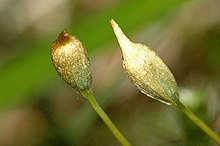This is an old revision of this page, as edited by Ruigeroeland (talk | contribs) at 06:43, 18 May 2011 (Cat). The present address (URL) is a permanent link to this revision, which may differ significantly from the current revision.
Revision as of 06:43, 18 May 2011 by Ruigeroeland (talk | contribs) (Cat)(diff) ← Previous revision | Latest revision (diff) | Newer revision → (diff)
| Polytrichum juniperinum | |
|---|---|

| |
| P. juniperinum | |
| Scientific classification | |
| Kingdom: | Plantae |
| Division: | Bryophyta |
| Class: | Polytrichopsida |
| Subclass: | Polytrichidae |
| Order: | Polytrichales |
| Family: | Polytrichaceae |
| Genus: | Polytrichum |
| Species: | P. juniperinum |
| Binomial name | |
| Polytrichum juniperinum | |
Polytrichum juniperinum, also known as juniper haircap moss, is an evergreen and perennial moss that is widely distributed, growing on every continent including Antartica.
Description
The stems are reddish with grey-green leaves that have a distinctive red-brown tip. This characteristic allows them to be separated from the bristly haircap, a plant that the juniper haircap moss have a close resemblance to; the difference is that the bristly haircap have a green tip. The leaves of juniper haircap moss are lanceolate and upright spreading when dry, and when moist, wide-spreading. Although their growth form can be varied, they generally grow in thin, interwoven mats, and hardly as closely associated individuals. Juniper haircap moss have a well-developed system of tiny tubes for carrying water from the rhizoids to leaves that is uncharacteristic of mosses, resembling the system that has evolved in vascular plants such as ferns, gymnosperms and angiosperms. As a result of this developed system, the stems grow taller than is usual for mosses.
Distribution
Juniper haircap moss grow across a wide gradient of habitats but it is most commonly found on dry, acidic, exposed habitats. It is frequent in areas that previously experienced disturbances such as fire and logging. Other areas they occupy are mineral soil, humus and rocks, stumps, banks, trailsides and dry open woods. Although Juniper haircap moss is not usually found in moist or wet environments, it has been found growing on moist woods and other moist sites such as streambanks.
Reproduction


It is a dioecious plant, meaning that the male and female gametophytes are on separate plants. Juniper haircap moss have very obvious male and female parts. Male plants are said to be unusual because they continue growing without losing the old male organs. The male plants are very noticeable due to their bright reddish orange modified leaves that form small terminal 'flowers' at the shoot ends. The plant has a gametophyte dominant life cycle similar to other mosses. Water is required for reproduction to take place, to enable the sperm to swim down the neck of the archegonia to reach the egg. Once fertilization takes place, the sporophyte of the juniper haircap moss lives on the female gametophyte, growing out of the archegonia. the sporophyte consists of a foot, stalk, a spore capsule, an operculum, and a calyptra. There are 64 short blunt teeth at the top surrounding the capsule mouth and the hood of the capsule, the calyptra, has long hairs that extends down the entire length of the capsule, hence the name 'haircap moss'.
Medicinal use
The herb has important medicinal uses because it is believed to be a form of a diuretic. Because it increases urinary secretions, it is useful in the treatment of urinary obstructions and dropsy, an old term for today's edema, which is defined by medicinenet as the swelling of tissue due to accumulation of excess water. The plant is also considered to be excellent for long term use because it does not cause nausea.
References
- ^ , Fire Effects Information System. U.S. Department of Agriculture, Forest Service, Rocky Mountain Research Station, Fire Sciences Laboratory.
- ^ , Plants For A Future. Plant Database.
- ^ , The British Bryological Society. British mosses and liverworts a field guide.
- ^
- ^ , Thunder Bay, ON, Lakehead University, Faculty of forestry and the forest environment (Producer).